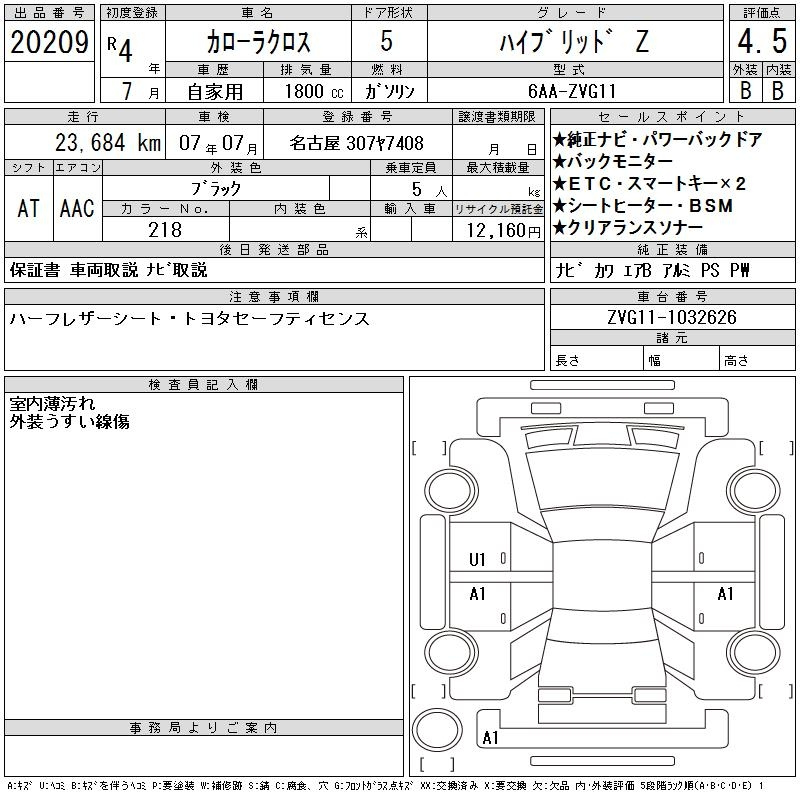
If you're importing a used vehicle from Japan, the auction sheet is your most trusted document. Created by certified inspectors from auction houses, it provides a clear summary of the car's condition, usage history, and key specifications—helping you make a smart purchase decision even without physically inspecting the car.
While most auction sheets are written in Japanese, understanding the main sections and symbols can give you a reliable overview of the car’s real condition. Let’s break down what to look for.
Key Information Found on the Auction Sheet
- Chassis Number: Also known as the VIN, this uniquely identifies each vehicle.
- Registration Date: The car's first registration date in Japan. Note that this is not always the manufacturing date—check with your dealer or exporter for exact production details.
- Mileage: Shows how many kilometers the vehicle has been driven within Japan.
Interior & Exterior Grading
Inspectors grade both the interior and exterior of the car to reflect wear and tear. Grades range from A to E:
Interior Grades:
- A – Like new, flawless interior.
- B – Very clean, near-new condition.
- C – Minor stains or signs of use.
- D – Noticeable cigarette burns, tears, or odors.
- E – Heavy damage, poor interior condition.
Exterior Grades:
- A – Excellent exterior, like brand new.
- B – Light scratches, barely visible.
- C – Noticeable scratches, small dents.
- D – Multiple dents, scratches, or rust patches.
- E – Poor condition with major body flaws.
Overall Auction Grades (S to R)
Each car also receives an overall grade, often written at the top of the auction sheet:
- S / 6 – Brand new or nearly new vehicle.
- 5 – Excellent used condition, minimal wear.
- 4.5 – Great shape, with some tiny flaws.
- 4 – Good used car, may have light scratches or stains.
- 3.5 – Noticeable cosmetic issues, light rust possible.
- 3 – Moderate wear and tear, dents, paint damage, stains.
- 2 – Poor condition, usually heavy corrosion.
- 1 – Flood-damaged or major issues.
- R / RA – Repaired after an accident.
- RB – Repaired from minor damage.
- X / XX / 99 – Requires part replacement or serious engine trouble.
Abbreviations You Might See
- AAC – Climate control
- AC – Air conditioner
- SRS – Airbags
- AW – Alloy wheels
- F5/F6 – Manual transmissions (5 or 6 speed)
- FA / AT – Automatic transmission
- KAWA – Leather seats
- NAVI – Navigation system
- PS / PW – Power steering / power windows
- SR – Sunroof
- TV – Television
- ABS / TRC – Anti-lock brakes / Traction control
Symbols on the Car Diagram
The auction sheet diagram shows the car's exterior using symbols and letters to mark damages. Here are common ones:
- A – Scratch
- U – Dent
- E – Small dent
- W – Repaired area
- S / C – Rust / Corrosion
- P – Paint imperfection
- H – Faded or damaged paint
- X – Needs part replacement
- XX – Part already replaced
- Y – Crack or hole
- R / RX – Repaired glass crack (RX = still needs replacement)
- G – Glass chip
Other Helpful Notes
The auction sheet also includes additional information like the seller’s comments, inspector’s notes, paint code, number of doors, seating capacity, and vehicle options.
However, keep in mind — the auction sheet doesn’t directly show the mechanical health or performance of the car. It’s a great tool, but not a substitute for expert advice or verification.
“Reading an auction sheet takes time, but it gives you confidence and clarity when buying a used Japanese car.”
If you're unsure how to analyze a sheet, don't worry — Carbiz Autos is here to help. We offer expert auction sheet verification and consultation so you can make informed decisions with full peace of mind.
